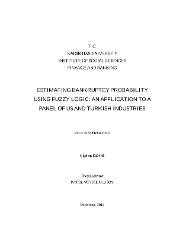| dc.contributor.advisor | Ulusoy, Veysel | en_US |
| dc.contributor.author | Özarı, Çiğdem | |
| dc.date.accessioned | 2019-07-12T08:29:58Z | |
| dc.date.available | 2019-07-12T08:29:58Z | |
| dc.date.issued | 2011 | |
| dc.identifier.uri | https://hdl.handle.net/20.500.12469/1869 | |
| dc.description.abstract | The main purpose of this study is to show how a Merton Model approach can be used to develop a new measure of company failures. probability independent from their sectors.in this study a new index Fuzzy-bankruptcy index is created which explains the default probability of any firm X independent from the sector it belongs. in the construction process in order to reduce the relativity of financial ratios due to the fact that their interpretation change with time and according to different sectors fuzzy logic is used. For the fuzzy process we used five input variables four of them are chosen from both factor analysis and clustering and the last input variable calculated from Merton Model. Looking back to the default history of firms one can find different reasons such as managerial arrogance fraud and managerial mistakes which are responsible for the very sad endings of well-known companies like Enron K-Mart and even the country Argentina. Thus we hope with the help of our Fuzzy-bankruptcy index one could be able to get a better insight into the financial situation a company is in and it could also prevent credit loan companies from investing in the wrong firm and possibly from losing the entire investment. This study is organized as seven chapters. Chapter one explains the factor analysis. Chapter two gives the definition of probability of default and outlines the methods for estimating default probability. it reviews the literature on estimating the default probabilities the Merton Model and its extensions. Chapter three explains the cluster analysis and fuzzy logic. it reviews the literature on clustering and methods of clustering especially explains the method of how to cluster variables in detail. Second part of chapter three explains fuzzy logic and its applications. it reviews the literature on applications of fuzzy logic and how and why we use fuzzy logic in our model. Chapter four gives the information of our study and describes the model we studied. Chapter five investigates the relationship between macro-economic factors and probability of default and Chapter six concludes. Chapter seven is appendix of our study. | en_US] |
| dc.language.iso | eng | en_US |
| dc.publisher | Kadir Has Üniversitesi | en_US |
| dc.rights | info:eu-repo/semantics/openAccess | en_US |
| dc.subject | N/A | en_US |
| dc.title | Estimating bankruptcy probability using fuzzy logic: an application to a panel of us and Turkish industries | en_US |
| dc.type | doctoralThesis | en_US |
| dc.department | Enstitüler, Lisansüstü Eğitim Enstitüsü, Finans ve Bankacılık Ana Bilim Dalı | en_US |
| dc.relation.publicationcategory | Tez | en_US |
| dc.identifier.yoktezid | 300573 | en_US |
















